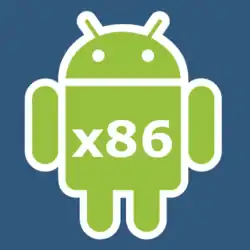Android-x86
Android-x86 was an open source project that made an unofficial porting of the Android mobile operating system developed by the Open Handset Alliance to run on devices powered by x86 processors, rather than RISC-based ARM chips.[2][3][4][5][6][7]
 | |
| Developer | Chih-Wei Huang, Yi Sun |
|---|---|
| OS family | Android (Linux) |
| Working state | Discontinued |
| Source model | Open source (includes proprietary components such as Google Play) |
| Latest release | 9.0-r2[1] (based on Android Pie 9.0.0_r54) / March 25, 2020 |
| Kernel type | Monolithic (modified Linux kernel) |
| License | Apache License 2.0 |
| Official website | www |

Developers Chih-Wei Huang and Yi Sun originated the project in 2009. The project began as a series of patches to the Android source code to enable Android to run on various netbooks, tablets and ultra-mobile PCs.
Overview
The OS is based on the Android Open Source Project (AOSP) with some modifications and improvements. Some components are developed by the project which allow it to run on PC architecture. For instance, some low-level components are replaced to better suit the platform, such as the kernel and HALs. The OS enables OpenGL ES hardware acceleration via Mesa if supported GPUs are detected, including Intel GMA, AMD's Radeon, Nvidia's chipsets (Nouveau), VMware (vmwgfx) and QEMU (virgl). Without a supported GPU, the OS can run in non-accelerated mode via software rendering. Since release 7.1, the software renderer has been implemented via the SwiftShader project.[8]
Like a normal Linux distribution, the project releases pre-built ISO images which can run under live mode or installed to a hard disk on the target system. Since release 4.4-r2, the project also releases efi_img[9] which can be used to create a live USB to be booted from on UEFI systems. Since release 4.4-r4, the UEFI support was united into the ISO images and efi_img was marked as deprecated.
Except AOSP, the following incomplete list of components are developed from scratch or derived from other open source projects to form the entire Android-x86 codebase:
- Kernel
- Installer
- drm_gralloc and gbm_gralloc
- Mesa
- SwiftShader
- Audio
- Camera
- GPS
- Lights
- Radio Interface Layer
- Sensors
More and more components may be added to the updated version.
| Version | Android version | Release date | Status |
|---|---|---|---|
| 0.9 | 1.5 (Cupcake) | 2009-07-29 | Discontinued |
| 1.6 | 1.6 (Donut) | 2009-11-20 | Discontinued |
| 2.2 | 2.1 (Eclair) | 2010-06-30 | Discontinued |
| 3.2 | 3.0 (Honeycomb) | 2011-08-28 | Discontinued |
| 4.0 | 4.0.4 (Ice Cream Sandwich) | 2013-06-23 | Discontinued |
| 4.2 | 4.2 (Jellybean) | 2012-12-25 | Discontinued |
| 4.3 | 4.3 (Jellybean) | 2013-07-25 | Discontinued |
| 4.4 | 4.4.2 (KitKat) | 2014-08-08 | Discontinued |
| 6.0 | 6.0.1 (Marshmallow) | 2016-09-13 | Discontinued |
| 7.1 | 7.1.2 (Nougat) | 2018-02-06 | Discontinued |
| 8.1 | 8.1.0 (Oreo) | 2019-01-15 | Discontinued |
| 9.0 | 9.0.0 (Pie) | 2020-02-27 | Discontinued |
| 10.0 | 10.0 (Q) | ? | Source Code |
| 11.0 | 11.0 (R) | ? | Source Code |
Android-x86 (Q) and (R) branches are only source code releases as of August 2022.[10]
Related projects
Project Celadon
A related project, Celadon (formerly Android-IA)[11] has been produced by Intel that will run on newer UEFI devices. The project states that its intention is to drive Android support and innovation on Intel Architecture in addition to providing a venue for collaboration.[11] It re-used the drm_gralloc graphics HAL module from Android-x86 in order to support Intel HD Graphics hardware. Back as Android-IA, it provided a FAQ[12] with more detailed information.
Remix OS
Jide Technologies partnered with Chih-Wei Huang, the main developer of Android-x86, on Remix OS, a closed-source derivative of Android-x86 designed for use on conventional PCs. The first beta of Remix OS was made available on March 1, 2016.[13] The project was discontinued on July 17, 2017.[14]
Android TV x86
In late 2020, a senior member of XDA Developers created Android TV x86 to provide Android TV for PCs, which "should work out of the box because the ROM has its roots in the Android-x86 project".[15]
See also
- Linux
- Anbox - A free and open-source compatibility layer that aims to allow mobile applications and mobile games developed for Android to run on Linux distributions.
- BlueStacks
- Windows Subsystem for Android
- DuOS-M
- List of operating systems
References
- "Release Note 9.0-r2". Android-x86.org. 2020-03-25. Retrieved 2020-05-28.
- DistroWatch Weekly, Issue 767, 11 June 2018
- Android-x86 4.0 review - Not impressed
- Android-x86 4.4 review – first Release Candidate | LinuxBSDos.com
- Android-x86 Just Might Make a Good Linux Desktop Alternative | Reviews | LinuxInsider
- DistroWatch Weekly, Issue 630, 5 October 2015
- DistroWatch Weekly, Issue 682, 10 October 2016
- "SwiftShader repo at Android-x86". android-x86 gitweb. Archived from the original on 9 July 2021. Retrieved 30 June 2021.
- "Android-x86 Release 4.4". android-x86@sourceforge. Retrieved 31 August 2015.
- "Get Source | Android-x86".
- "Home". Android Open Source Platform for Intel Architectures. Retrieved 2020-09-15.
- "FAQ". Android on Intel Architecture. Archived from the original on 31 December 2013. Retrieved 3 January 2014.
- "[ANNOUNCEMENT] Release of Remix OS for PC Be... | Remix OS". Forum.xda-developers.com. 2016-03-01. Retrieved 2017-05-02.
- Jide Tech (2017-07-17). "An update from Jide Team". Kickstarter.com. Retrieved 2020-07-12.
- "Android TV x86 lets you repurpose your old PC into a media streamer". XDA Developers. 2020-11-14. Retrieved 2020-11-16.